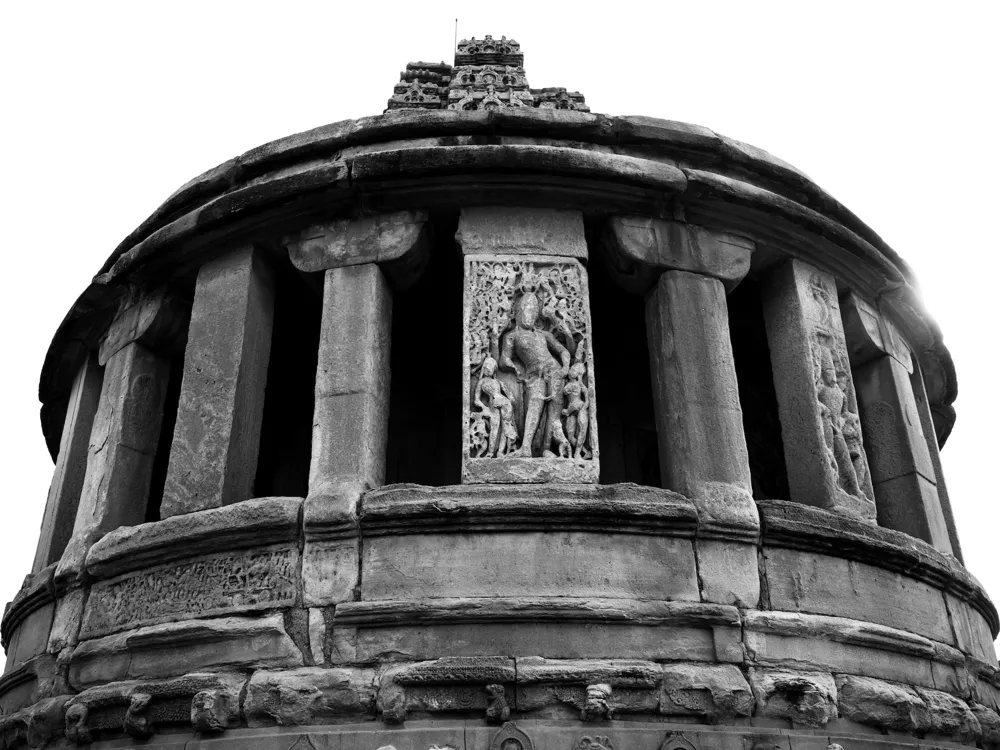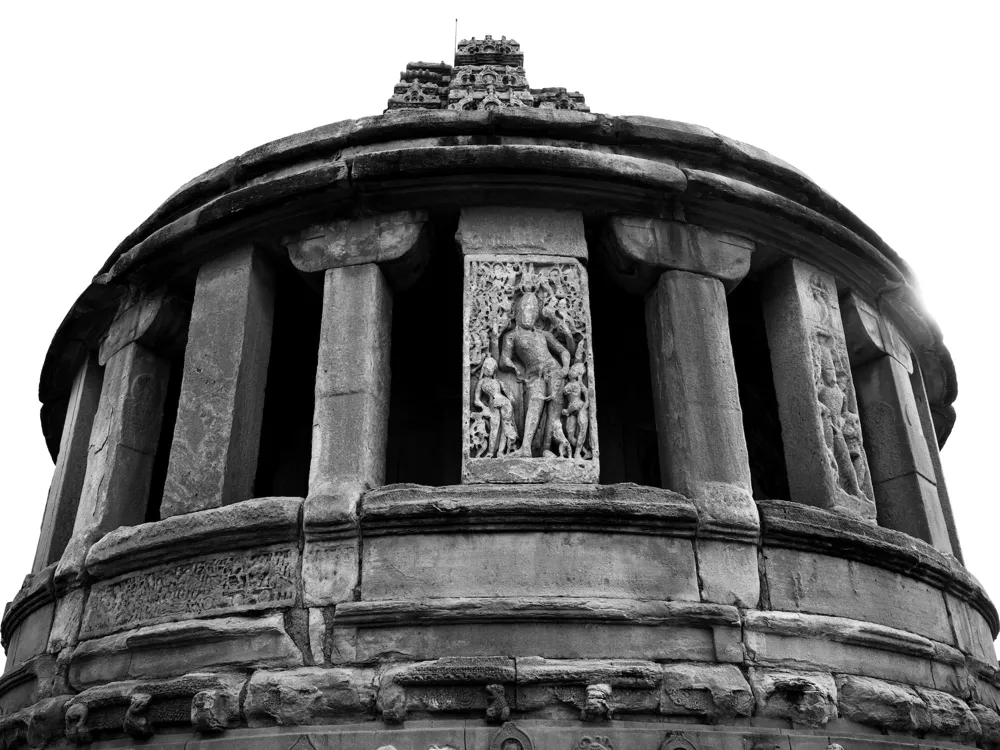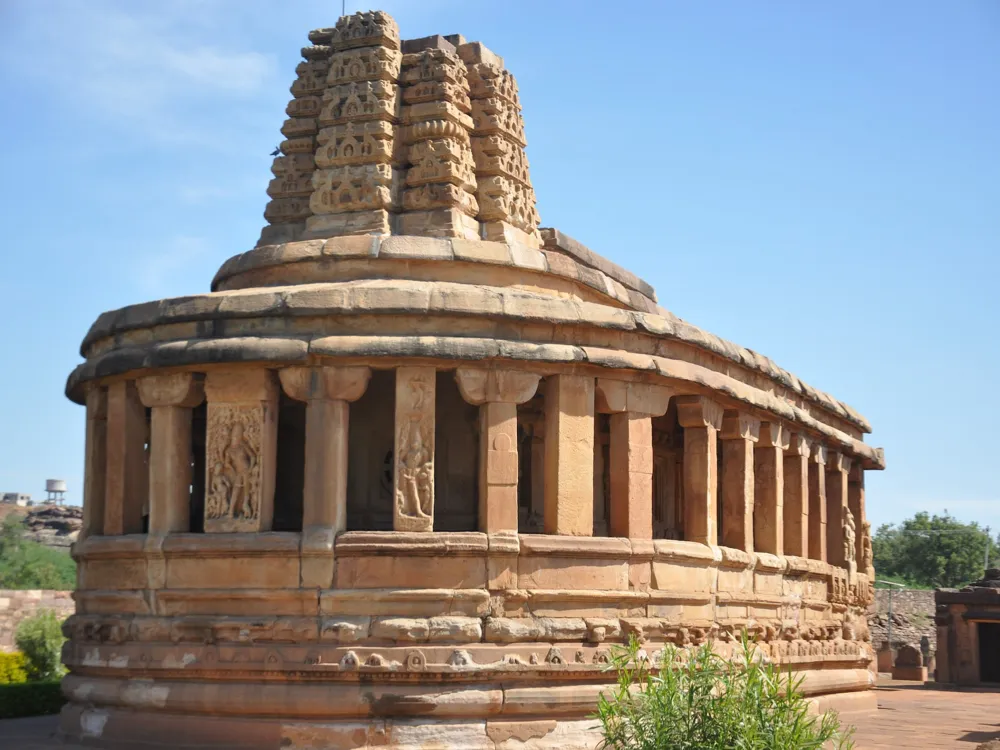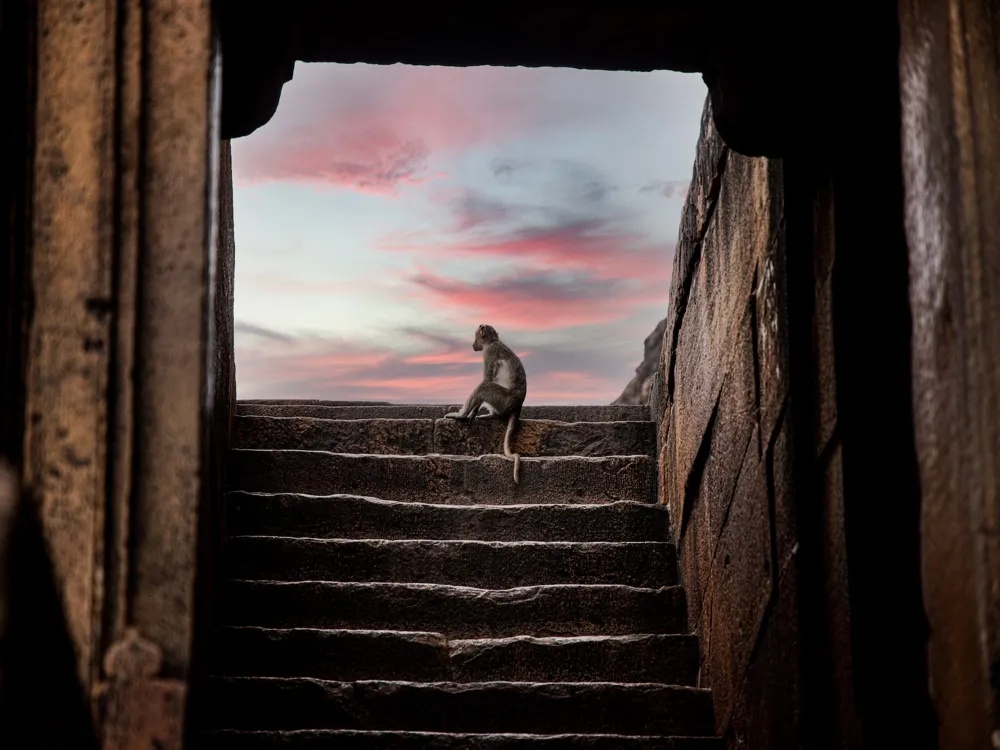Nestled in the quaint town of Aihole in Karnataka, Halabasappana Gudi stands as a testament to India's rich architectural heritage. This ancient temple, dating back to the 7th century, is a significant relic of the Chalukyan era, renowned for its intricate carvings and historical significance. Aihole, often referred to as the 'Cradle of Hindu Rock Architecture,' hosts about 125 temples, with Halabasappana Gudi being a prominent attraction. This temple, dedicated to Lord Shiva, exhibits a fusion of Dravidian and Nagara styles, making it a unique specimen in the realm of Indian temple architecture. The temple's layout follows a simple yet elegant design, commonly seen in early Chalukyan architecture. It features a sanctum (garbhagriha), a vestibule (antarala), and a main hall (navaranga), each demonstrating the meticulous craftsmanship of the era. The outer walls are adorned with a series of carved panels depicting various deities and mythological narratives, offering a glimpse into the religious and cultural milieu of the time. The temple's most striking feature is its shikhara or tower, which exhibits a tiered, pyramid-like structure typical of the Dravidian style. The base of the shikhara showcases intricate carvings of mythical creatures and floral motifs, a hallmark of Chalukyan artistry. Inside, the sanctum houses a Shiva lingam, symbolizing the presiding deity. The temple's interior is relatively modest, with fewer embellishments, directing the focus to the sanctified deity. Halabasappana Gudi not only serves as a place of worship but also as a mirror reflecting the sociopolitical scenario of its time. It provides valuable insights into the religious practices, art, and architecture of the Chalukyan period. The temple's enduring beauty and historical significance make it a must-visit for history enthusiasts and spiritual seekers alike. The architecture of Halabasappana Gudi in Aihole is a splendid example of the fusion between the Dravidian and Nagara styles, characteristic of the early Chalukyan period. The temple's design is a harmonious blend of southern and northern Indian temple architectural idioms, making it a unique and invaluable part of India's cultural heritage. The temple's base is elevated, a feature typical of Chalukyan temples, providing a heightened sense of grandeur. The outer walls are profusely decorated with panels of exquisite carvings, depicting scenes from Hindu epics, such as the Ramayana and Mahabharata, as well as various forms of Lord Shiva and other deities. These carvings are not just decorative elements but also serve as a medium for storytelling, conveying religious and mythological narratives to the devotees and visitors. The shikhara or tower of Halabasappana Gudi is a distinguished feature, showcasing the convergence of Dravidian and Nagara styles. It rises majestically above the sanctum, with a series of miniature decorative towers that culminate in a large, amalaka (ribbed, circular stone) at the top. The tower's design is intricate, with each tier featuring a detailed array of sculptures and motifs. The interior of the temple is relatively simple compared to its elaborate exterior. The sanctum, housing the deity, is a small, dark chamber, designed to evoke a sense of mystique and reverence. The temple's main hall or navaranga is where the devotees gather, and it features pillars with detailed carvings, adding to the temple's artistic richness. The integration of various architectural elements in Halabasappana Gudi demonstrates the ingenuity and skill of the Chalukyan artisans. Their ability to blend different styles into a cohesive and harmonious design is what makes this temple a masterpiece of Indian architecture. As a place of worship, it is important to dress modestly. Comfortable, non-revealing clothing is recommended to respect the sanctity of the temple. Check for any restrictions on photography inside the temple. While capturing the temple's beauty, be mindful not to disturb the sanctity of the worship areas. Consider hiring a local guide to enrich your visit with historical insights and stories about the temple's past. Observe and respect local customs, especially during religious ceremonies. It's a good opportunity to witness the temple's cultural significance. Halabasappana Gudi in Aihole is accessible by various modes of transportation. The nearest major city is Bagalkot, which is well-connected by road and rail. From Bagalkot, Aihole is a short drive away. Visitors can also reach Aihole by bus from major cities in Karnataka, including Bengaluru and Hubli. For those preferring to travel by air, the nearest airport is in Hubli, from where one can hire a taxi or take a bus to Aihole. Local transportation within Aihole is readily available for easy access to the temple. Read More:Overview of Halabasappana Gudi, Aihole, Karnataka
Architecture of Halabasappana Gudi
Tips When Visiting Halabasappana Gudi
Dress Appropriately
Photography Rules
Guided Tours
Local Customs and Etiquette
How To Reach Halabasappana Gudi
Halabasappana gudi
Aihole
Karnataka
NaN onwards
View aihole Packages
Aihole Travel Packages
View All Packages For Aihole
Top Hotel Collections for Aihole

Private Pool

Luxury Hotels

5-Star Hotels

Pet Friendly
Top Hotels Near Aihole
Other Top Ranking Places In Aihole
View All Places To Visit In aihole
Faq on Aihole
What is Halabasappana gudi in Aihole?
Halabasappana gudi in Aihole is a temple dedicated to Lord Halabasappa, a deity worshipped by the local community. It is one of the many ancient temples in Aihole, Karnataka, known for its architectural significance and historical importance.
When was Halabasappana gudi built in Aihole?
The exact date of construction of Halabasappana gudi is not precisely known, but it is believed to date back to the ancient period of Aihole's history, possibly around the 6th to 8th centuries CE.
What is the significance of Halabasappana gudi in Aihole?
Halabasappana gudi holds religious significance as a place of worship for devotees of Lord Halabasappa. It also serves as a testament to the architectural and cultural heritage of the region, reflecting the artistic prowess of ancient craftsmen.
How to reach Halabasappana gudi in Aihole?
Halabasappana gudi is located in Aihole, a historical town in the Bagalkot district of Karnataka, India. Visitors can reach Aihole by road from nearby cities like Bagalkot and Pattadakal. The temple is easily accessible within the town and can be reached by local transportation or on foot.
Is Halabasappana gudi open to tourists?
Yes, Halabasappana gudi is open to tourists and visitors interested in exploring the rich heritage of Aihole. Visitors are welcome to admire the temple's architecture, learn about its history, and experience the spiritual ambiance of the site.
View aihole Packages
Aihole Travel Packages
View All Packages For Aihole
Top Hotel Collections for Aihole

Private Pool

Luxury Hotels

5-Star Hotels

Pet Friendly
Top Hotels Near Aihole
Other Top Ranking Places In Aihole
Faq on Aihole
What is Halabasappana gudi in Aihole?
Halabasappana gudi in Aihole is a temple dedicated to Lord Halabasappa, a deity worshipped by the local community. It is one of the many ancient temples in Aihole, Karnataka, known for its architectural significance and historical importance.
When was Halabasappana gudi built in Aihole?
The exact date of construction of Halabasappana gudi is not precisely known, but it is believed to date back to the ancient period of Aihole's history, possibly around the 6th to 8th centuries CE.
What is the significance of Halabasappana gudi in Aihole?
Halabasappana gudi holds religious significance as a place of worship for devotees of Lord Halabasappa. It also serves as a testament to the architectural and cultural heritage of the region, reflecting the artistic prowess of ancient craftsmen.
How to reach Halabasappana gudi in Aihole?
Halabasappana gudi is located in Aihole, a historical town in the Bagalkot district of Karnataka, India. Visitors can reach Aihole by road from nearby cities like Bagalkot and Pattadakal. The temple is easily accessible within the town and can be reached by local transportation or on foot.
Is Halabasappana gudi open to tourists?
Yes, Halabasappana gudi is open to tourists and visitors interested in exploring the rich heritage of Aihole. Visitors are welcome to admire the temple's architecture, learn about its history, and experience the spiritual ambiance of the site.


















